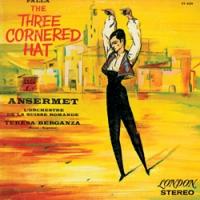ORG and Esoteric Polish Yet Another Decca/London Sonic Crown Jewel
As the liner notes point out, there’s nothing inauthentic about a Swiss composer conducting a Swiss orchestra performing a ballet written by a Spaniard.
Ansermet conducted the world premiere of “LeTricorne” in 1919 and it wasn’t in Spain. It was in Leicester Square in the UK at a theater appropriately named The Alhambra that’s long since been torn down. Sergei Diaghilev’s The Ballets Russes danced, and costumes were by Picasso. It must have been something to hear and see!
As the liner notes point out, there’s nothing inauthentic about a Swiss composer conducting a Swiss orchestra performing a ballet written by a Spaniard.
Ansermet conducted the world premiere of “LeTricorne” in 1919 and it wasn’t in Spain. It was in Leicester Square in the UK at a theater appropriately named The Alhambra that’s long since been torn down. Sergei Diaghilev’s The Ballets Russes danced, and costumes were by Picasso. It must have been something to hear and see!
This sonic spectacular is one of British Decca’s finest productions, originally issued in 1962 as SXL 2296 and recorded in 1961 in Geneva's narrow, deep Victoria Hall. How collectible is it? There’s a copy on Ebay UK as I write this currently bid at £145 or around $350 and the bidding has five days to go. An American London “Blueback” original recently sold for $125.
Which makes this superb sounding double 45rpm edition from ORG a relative bargain at $55. You’ll know it’s a sonic blockbuster from the fiery opening passage, the men’s shouts, the chorus of castanets and handclaps, Teresa Berganza’s short vocal interlude from the very back of the stage and the trumpet’s announcement.
You don’t have to know the story or see the dancing to get swept up in the musical drama the exudes but you can be sure it involved lechery, mistaken identity, an accident and all sorts of shenanigans that play out in music that is by turns filled with official misconduct, bravado, mischief, chicanery and finally the casting off of an hated villain.
Rounding out side two is the “Interlude and Dance” from Falla’s only opera, “La Vida Breve,” written when he was in his early twenties. It involves, love, betrayal and death, but well else is new?
The recording is nothing short of astonishing in every way: instrumental timbers are rich and full, dynamics full bore, soundstaging spacious and deep and transparency fully realized. It’s a pulse-quickening, cinematic-like ride musically and sonically, filled with Spanish-style fire and verve.
I have a later American white back cover copy of CS 6224 (an FFRR not FFSS) that I picked up when radio station WNCN stopped broadcasting classical music and sold off the record collection and even it sounds very good.
Recently, the Japanese audio company Esoteric/TEAC issued some vinyl and this was one of the titles. It’s version began with a high resolution transfer from the master tape at 192k/24 bit using Esoteric converters and a G-0Rb Rubidium Master Clock Sync Generator and Mexcel cables.
Lacquers were cut at the JVC Mastering Center on a Neumann VMS60 lathe fitted with an SX-74 cutter head driven by a Neumann SP-75 amplifier customized by JVC. 1000 copies only of the record were pressed on 200g vinyl in Japan from the original lacquer plating in a “one step” process. Esoteric used the original UK artwork and in a green frame for the cover art, and the original UK SXL label plus an insert showing the conductor and the hall. It’s a brilliant production that costs around $70.
However, while it does sound very, very good, I thought the all-analog ORG edition sounded richer, more transparent and especially more spacious, though if you bought the Esoteric, I think you’re set for this title! It’s very, very good.
Highly recommended musically and sonically!
- Log in or register to post comments




